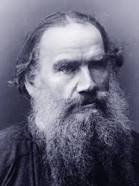How Trees Walk
"How Trees Walk" is a philosophical tale by Leo Tolstoy that explores the deep connection between humanity and nature. Through a whimsical narrative, the story revolves around the idea of how trees, often seen as stationary and silent, possess their own form of life and agency. Tolstoy delves into themes of growth, resilience, and the interconnectedness of all living things, encouraging readers to reflect on their relationship with the natural world. The narrative serves as a gentle reminder of the wisdom found in nature and the importance of observing and honoring its wonders.
One day we were cleaning an overgrown path on a hillock near the pond. We cut down a lot of brier bushes, willows, and poplars,--then came the turn of a bird-cherry. It was growing on the path, and it was so old and stout that it could not be less than ten years old. And yet I knew that five years ago the garden had been cleaned. I could not understand how such an old bird-cherry could have grown out there. We cut it down and went farther. Farther away, in another thicket, there grew a similar bird-cherry, even stouter than the first. I looked at its root, and saw that it grew under an old linden. The linden with its branches choked it, and it had stretched out about twelve feet in a straight line, and only then came out to the light, raised its head, and began to blossom. I cut it down at the root, and was surprised to find it so fresh, while the root was rotten. After we had cut it down, the peasants and I tried to pull it off; but no matter how much we jerked at it, we were unable to drag it away: it seemed to have stuck fast. I said: "Look whether it has not caught somewhere." A workman crawled under it, and called out: "It has another root; it is out on the path!" I walked over to him, and saw that it was so. Not to be choked by the linden, the bird-cherry had gone away from underneath the linden out on the path, about eight feet from its former root. The root which I had cut down was rotten and dry, but the new one was fresh. The bird-cherry had evidently felt that it could not exist under the linden, so it had stretched out, dropped a branch to the ground, made a root of that branch, and left the other root. Only then did I understand how the first bird-cherry had grown out on the road. It had evidently done the same,--only it had had time to give up the old root, and so I had not found it.
Translation
Translate and read this book in other languages:
Select another language:
- - Select -
- 简体中文 (Chinese - Simplified)
- 繁體中文 (Chinese - Traditional)
- Español (Spanish)
- Esperanto (Esperanto)
- 日本語 (Japanese)
- Português (Portuguese)
- Deutsch (German)
- العربية (Arabic)
- Français (French)
- Русский (Russian)
- ಕನ್ನಡ (Kannada)
- 한국어 (Korean)
- עברית (Hebrew)
- Gaeilge (Irish)
- Українська (Ukrainian)
- اردو (Urdu)
- Magyar (Hungarian)
- मानक हिन्दी (Hindi)
- Indonesia (Indonesian)
- Italiano (Italian)
- தமிழ் (Tamil)
- Türkçe (Turkish)
- తెలుగు (Telugu)
- ภาษาไทย (Thai)
- Tiếng Việt (Vietnamese)
- Čeština (Czech)
- Polski (Polish)
- Bahasa Indonesia (Indonesian)
- Românește (Romanian)
- Nederlands (Dutch)
- Ελληνικά (Greek)
- Latinum (Latin)
- Svenska (Swedish)
- Dansk (Danish)
- Suomi (Finnish)
- فارسی (Persian)
- ייִדיש (Yiddish)
- հայերեն (Armenian)
- Norsk (Norwegian)
- English (English)
Citation
Use the citation below to add this book to your bibliography:
Style:MLAChicagoAPA
"How Trees Walk Books." Literature.com. STANDS4 LLC, 2025. Web. 22 Feb. 2025. <https://www.literature.com/book/how_trees_walk_3977>.








Discuss this How Trees Walk book with the community:
Report Comment
We're doing our best to make sure our content is useful, accurate and safe.
If by any chance you spot an inappropriate comment while navigating through our website please use this form to let us know, and we'll take care of it shortly.
Attachment
You need to be logged in to favorite.
Log In